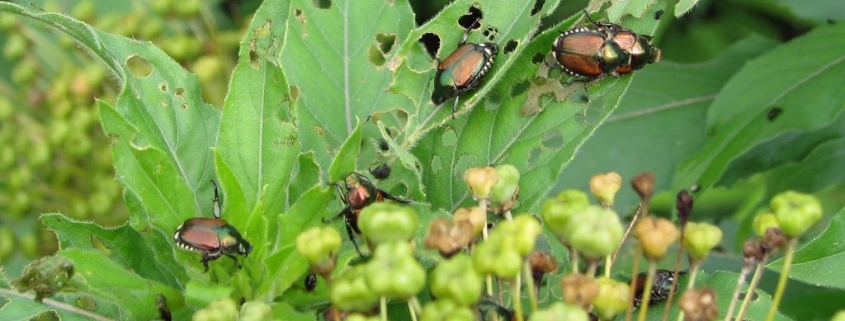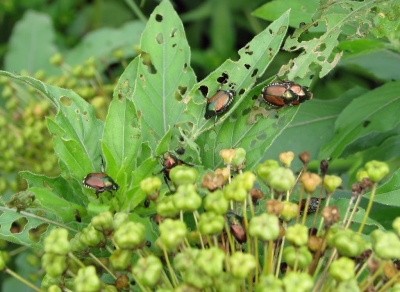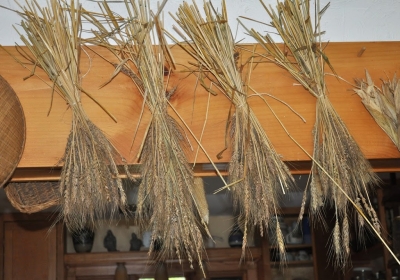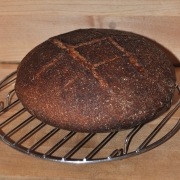Just as cicadas are returning to their underground homes, Japanese beetles are emerging from these same quarters. (Do they nod to each other as they pass?) In contrast to the 17 year hiatus of the cicadas, Japanese beetles come up to cause trouble every year. Some years are worse than others, and the threat is hard to predict ahead of time.
Last year I was braced for an onslaught because of a moist summer the year before. Moist soil is ideal for the beetles’ egg-laying. Eggs laid later in summer hatch into grubs that feed on roots, especially grass
roots, and emerge the following season. (Beetle grubs are allegedly good eating as are, allegedly, cicada adults.) The beetle onslaught began on schedule last year, then fizzled out. I don’t know what to expect this year, except that I’ve already seen quite a few beetles.
I also don’t know what to do about them. Milky spore disease is a bacterium that specifically targets the grubs in the soil. That seems ideal, except “there’s many a slip ‘twixt the cup and the lip.” Milky spore disease is more effective in theory and in the laboratory than out in real life. Beneficial nematodes are another potential fix for “beetlemania,” but nematodes are unfortunately also subject to that “slip.” Even if either beneficial organism was 100% effective, it would do nothing for the grubs in neighbors’ yards; those grubs morph into beetles that, once they spread their wings on neighbors’ lawns, could just fly over here.
I’ve tried Japanese beetle traps and they were effective in the early years of light infestations here. After awhile, though, the traps attracted more beetles than they trapped even though placed about 300 feet apart at either end of my property.
I’ve never tried, but like the idea of, strapping long, spiked soles to the bottom of my shoes and walking around spearing the grubs. It may be effective, but, again, does nothing about neighbors’ grubs unless you pace their yards also.
Hand to hand combat is most effect and satisfying. The beetles are sluggish in early morning and easily flicked off leaves into a jar of soapy water, the soap preventing their escape. The problem, for me, is too, too many plants for hand to hand combat. The organic spray ‘Surround’, nothing more than kaolin clay, is a deterrent, but again, I have too many plants to douse repeatedly with anything, organic or otherwise.
——————————————
Good gardeners keep a close eye on their plants. Good gardeners also — I believe — purposely don’t always look too closely. I have a friend whose fruit trees look almost perfect, the result of lots of pesticide sprays. He could get by with a lot less spraying if a few holes in leaves or occasional wormy apples upset him less, which might happen if he looked less closely.
Plants tolerate a certain amount of insect and disease damage. More than that, plants compensate, ratcheting up photosynthesis in what’s left of their leaves following damage — up to a point.
Anyway, the last sentence is the rationale for my do-nothing approach to Japanese beetles. I’m also reassured knowing that, although the beetles have cosmopolitan tastes, they don’t attack everything. Two years ago, for some reason, they skeletonized many leaves on one hardy kiwi plant (Actinidia kolomikta) but left a neighboring one (also A. kolomikta) practically untouched.
——————————————
Except for a few sparrows pecking at seeds, my wheat crop has been pest-free, even from Japanese
beetles. The wheat harvest came in last week. Lest you think that “came in” implies sacks of grain, the area planted was a mere 5 foot length of one of the 3 foot wide vegetable beds.
This wheat was winter wheat, planted last September. The green sprouts grew through autumn, went dormant in winter, then started growing again in spring, beginning to develop seed heads once the plants were a couple of feet tall.
Over the past few weeks the stalks rose to 5 feet high and the seed heads plumped up. Last week, rich soil, drip irrigation, and birds finally got the best of the upright stalks. Enough of them began to flop down and turn tawny that methought harvest was in order so we went at the stalks with pruning shears and threw them in a bucket. The stalks are now tied into small bundles that hang from a kitchen rafter to finish drying.
I’m planning to plant cabbage and broccoli transplants in the 15 square feet vacated by the wheat. I
could have planted right in the wheat stubble but decided, instead, to pull out clumps of wheat plants with minimal disturbance of the soil, spread on inch of compost, and plant. Grasses have extensive root systems (380 miles estimated beneath a single rye plant, another plant in the grass family), and all those wheat roots pushing and prodding the soil hither and thither left the ground in the wheat bed wonderfully soft and crumbly.
Once the wheat harvest is dry, I’ll thresh, winnow, and grind it, then report on the yield, in loaves of bread per square foot of growing area.










What are you going to do with the wheat?
Thresh it, winnow it, grind it, and make bread.
Very curious about the square foot return on that wheat growth. I believe potatoes is the most dense return… although I wonder about zucchini.
I think you’re right about potatoes. “Return” generally means calories per unit area. Zucchini might put out a lot, perhaps the most, weight per unit area, but surely not the most calories.
Any idea yet about the loaves per square foot? We plan on putting wheat in the ground this weekend. It’d be cool to know what to expect.
I’m still trying to get a way to effectively thresh the wheat. Beating it in a pillow case didn’t dislodge hardly any seeds.